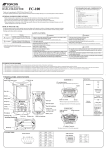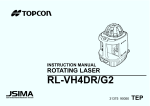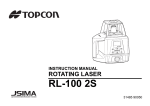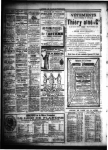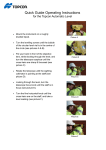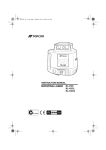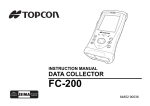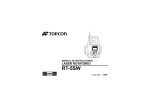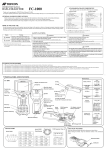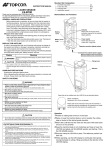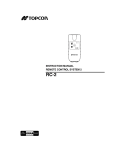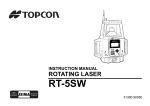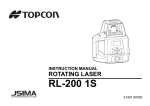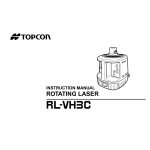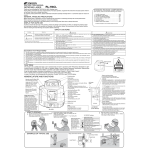Download RL-VH4G - ToppTopo A/S
Transcript
INSTRUCTION MANUAL ROTATING LASER RL-VH4G 31339 90051 TEP Declaration of Confomity R&TTE Directive 1995/5/EC WE: TOPCON @CORPORATION 75-1 Hasunuma-cho Itabashi-ku Tokyo Japan declare on our own responsibility, that the product; Kind of Product: Rotating Laser Type designation: RL-VH4G is in compliance with the following norm(s) or documents; Radio :EN 300 220-3 V1.1.1 EMC :EN 301 489-3 V1.4.1 safety :EN 60950-1 Foreword Thank you for purchasing the Topcon RL-VH4G Rotating Laser. It is one the world’s most advanced lasers. To quickly and effectively use the RL-VH4G, please read these brief instructions carefully, and keep them in a convenient location for future reference. Handling Precautions Before starting work or operation, be sure to check that the system is functioning properly. 1. Vibration and Impact Protection When transporting the instrument, provide protection to minimize risk of severe vibration or impact. Severe vibration or impacts may affect beam accuracy. 2. Laser Scanning Interference Particular reflective surfaces such as mirrors and some glass surfaces, can cause beam reflection that in very rare circumstances can interfere with the laser scanning function. If this should happen, simply change the location of the laser or cover the reflective surface. 3. Checking battery power. Before operating, check remaining battery life. 4. Storing the instrument for long period When storing the instrument for long period, remove the batteries. 5. Rotating Head When sunlight, etc. enters the laser emitting window, laser beam output may temporarily decrease. In such a case, prevent sunlight, etc. from entering by using a parasol or other means. 1 Safety Information In order to encourage the safe use of products, to prevent damage to properties, and to prevent any danger to the operator and to others, important warnings are placed on the products and inserted in the instruction manuals. We suggest that everyone understand the meaning of the following displays and icons before reading the “Safety Cautions” and text. Display Meaning WARNING Ignoring or disregard of this display may lead to death or serious injury. CAUTION Ignoring or disregard of this display may lead to personal injury or physical damage to the instrument. Injury refers to hurt, burn, electric shock, etc. Physical damage refers to damage to equipment and structure or furnishings. 2 Safety Cautions WARNING • There is a risk of fire, electric shock or physical harm if you attempt to disassemble or repair the instrument yourself. This is to be carried out by TOPCON or an authorized dealer, only! • Laser beam can be dangerous, and can cause eye injury if used incorrectly. Never attempt to repair the instrument yourself. • Cause eye injury or blindness. Do not stare into beam. • Risk of fire or electric shock. Do not use a wet battery. • May ignite explosively. Never use an instrument near flammable gas or liquid matter, and do not use in a coal mine. • Battery can cause explosion or injury. Do not dispose in fire or heat. • The short circuit of a battery can cause a fire. Do not short circuit battery when storing it. 3 CAUTION Use of controls or adjustment or performance of procedures other than those specified herein may result in hazardous radiation exposure. Let the laser beam reach the aimed object or the target without anybody else in the laser beam path. When operating in an open area, avoid radiating laser beam at eye level. It is quite possible for the beam to enter into one's eyes, and it is possible to lose visual sight temporarily, and lose one's caution and awareness of other dangers - avoid glaring beam. Do not allow skin or clothing to come into contact with acid from the batteries, if this does occur then wash off with copious amounts of water and seek medical advice. Risk of injury by dropping the instrument or case. Do not use a carrying case with damaged belts, grips or latches. It could be dangerous if the instrument falls over, please check that you fix the instrument to the wallmount or tripod. Risk of injury by dropping a tripod and an instrument. Always check that the screws of tripod are tightened. Please note that the tips of tripod can be hazardous, be aware of this when setting up or carrying the tripod. 4 User Wear the required protectors (safety shoes, helmet, etc.) when operating. Exceptions from Responsibility 1) The user of this product is expected to follow all operating instructions and make periodic checks of the product’s performance. 2) The manufacturer, or its representatives, assumes no responsibility for results of a faulty or intentional usage or misuse including any direct, indirect, consequential damage, and loss of profits. 3) The manufacturer, or its representatives, assumes no responsibility for consequential damage, and loss of profits by any disaster, (an earthquake, a fire, an accident, storms, floods, an act of a third party and/or a usage other than under normal conditions.) 4) The manufacturer, or its representatives, assumes no responsibility for any damage, or loss of profits due to a change of data, loss of data, an interruption of business etc., caused by using the product or an unusable product. 5) The manufacturer, or its representatives, assumes no responsibility for any damage, or loss of profits caused by usage other than those usages explained in the user manual. 6) The manufacturer, or its representatives, assumes no responsibility for damage caused by wrong movement, or action due to connecting with other products. 5 Laser Safety This product projects a visible laser beam during operation. This product is manufactured and sold in accordance with “Performance Standards for Light-Emitting Products” ( FDA/BRH 21 CFR 1040) or “Radiation Safety of Laser Products, Equipment Classification, Requirements and User’s Guide” (IEC Publication 60825-1) provided on the safety standards for laser beam. As per the said standard, this product is classified as “Class 3R (IIIa) Laser Products”. This is a simple product to operate and does not require training from a laser safety officer. In case of any failure, do not disassemble the instrument. Contact TOPCON or your TOPCON dealer. Labels Beam aperture Beam aperture AVOID EXPOSURE LASER LIGHT IS EMITTED FROM THIS APERTURE 6 RL-VH4G standard model Contents Foreword ............................................. 1 Handling Precautions ........................ 1 Safety Information ............................. 2 Safety Cautions ................................ 3 User .................................................. 5 Exceptions from Responsibility ......... 5 Laser Safety ...................................... 6 Contents ........................................... 7 Standard System Components ......... 8 Nomenclature and Functions ............ 9 Preparation for Use ............................ 11 Battery Installation ............................ 11 Instrument Set-up Procedure ............ 11 Horizontal Rotation ........................... 11 Vertical Rotation ................................ 12 Battery Warning Lamp ...................... 12 Auto-leveling Lamp ........................... 12 Turning Auto-Leveling off .................. 12 Operation ............................................. 13 Scanning Mode ................................. 13 Continuous Scan .............................. 14 Laser Sensor Mode .......................... 15 Laser Pointing Mode (stop) ............... 15 Changing Rotation Speed ................. 15 How to Remove/Install Head Protector ...................16 Height Alert Function .........................19 Setting Slopes ...................................20 How to Set Slopes .............................21 Cancelling Slope Settings .................21 Line Control (manual vertical beam alignment) .....22 RC-30 Remote Control ........................24 Description of RC-30 Functions .........25 How to Set Remote Control Communication Channel.................26 Maintaining Power Sources ...............27 Replacing Dry Batteries ....................27 Checking and Adjusting .....................28 Horizontal Calibration ........................29 Horizontal Rotation Cone Error ..........33 Vertical Calibration ............................34 Standard / Optional Accessories .......38 Storage Precautions ...........................41 How to Store ........................................42 Specifications ......................................44 Error Code ...........................................46 7 Standard System Components 1 2 3 4 5 6 7 8 RL-VH4G Instrument............................................................................. 1pc. Remote Controller RC-30 *1) ................................................................. 1pc. Magnetic Target .................................................................................... 1pc. Battery unit *2) ....................................................................................... 1set AA-size dry batteries ........................................................................... 3pcs. Carrying case ....................................................................................... 1pc. Calibration decals.................................................................................. 1set Instruction manual................................................................................. 1vol. • Please make sure that all of the above items are in the box when you unpack. • Additional Magnetic Scanning Targets may be included in some markets. • Standard System Components will differ depend on the markets. Optional Accessories(P38) may be included in some markets. *1) Remote Controller RC-30 may not be included as attachment in some systems. *2) The following are battery configurations. Included battery configurations vary by package. Rechargeable battery type: (with Built-in Run/Charge system) Rechargeable battery (BT-63Q)......1pc. Holder (DB-49C) .............................1pc. AC/DC converter.............................1pc. 8 Dry battery type: Holder (DB-58)................................1pc. D- cell............................................ 4pcs. Nomenclature and Functions RL-VH4G Rotary head Laser emitting window Beam aperture Head protector Magnetic Scanning Target Lock button Handle Magnet Datum line Index Index Control panel Reflectors Lines may appear on the reflector strips. Leveling screw They are part of normal manufacturing process and do not effect performance. Battery holder Battery compartment lock 9 Control Panel Leveling lamp Low battery alert Flashing: Laser is leveling On: Auto-leveling is completed (RL-VH4G remote control model has standby mode) Power switch Mode switch control Alignment control Laser mode is switched alternately as follows. Scan mode Head rotates slowly, searching for Magnetic Scanning Target. When target is placed in beam path, laser rapidly scans back and forth on target. X/Y axis lamp Level For vertical operation X/Y axis selection key Select X or Y axis for manual beam sloping. Manual mode lamp ON: Manual leveling mode OFF: Auto-leveling mode Auto/manual leveling control Speed control With 'Laser Pointing Mode' selected, the rotation speed of the head can be changed. Laser sensor mode Laser sensor mode Head rotates at 300 rpm. Use this setting when using an optional electronic laser sensor such as the Topcon LS-70. Laser pointing mode ON/OFF of Auto-leveling. To turn off Head stops rotating and the the auto-leveling, press this key twice. beam can be positioned by To turn on the auto-leveling again, manually turning the head. press this key once. The laser output is not stable for several minutes when the power is on or the mode of laser is changed. After the beam is stabilized (display does not show WAIT), the mode can be changed. 10 Preparation for Use Battery Installation For battery placement or replacement instructions, see Maintaining Power Sources section, page 27. Instrument Set-up Procedure Horizontal Rotation 1 Set the instrument on any smooth surface that is within ±5° of true level. The RL-VH4G auto-level system will not function if the unit is placed more that 5° out of level. For best operation, it is recommended that it be mounted to a tripod or the Topcon Wall Mount Model 1C . Slope can be set in both axes, X and Y. See "Setting Slope" section, page 20. Horizontal Leveling range 11 Vertical Rotation 1 2 Place the instrument on its back as shown in the illustration. Turn the leveling screw (s) underneath the instrument until the bubble in the level vial on the operational panel is centered. Battery Warning Lamp Flashing : The power is low ON Solid: Dead batteries Replace the batteries with new ones. Auto-leveling Lamp Flashing : Auto-leveling is in process. When automatic leveling is almost complete, the flashing rate will be slow. The head will not rotate and the laser beam will not emit during the auto-leveling process. ON Solid : Auto-leveling is complete. The rotary head is active and emits the laser beam. Turning Auto-leveling Off To turn OFF the auto-leveling function (manual mode), press the Auto/Manual control pad twice in quick succession. The manual mode indicator light will illuminate. The instrument can be positioned in any direction, the laser beam remains on and the head will rotate. IMPORTANT: In manual mode, the laser beam will not shut off if disturbed! To return to Autoleveling mode, press Auto/Manual control pad once. 12 Operation Scanning Mode In scan mode, the laser rotates slowly, "searching" for the Magnetic Scanning Target. When the target is properly placed in the beam path, the laser beam will scan rapidly back and forth on the target and "track" the target as it is moved in its path. 1 To change to scanning mode when operating, press the Mode Control Pad (see page 10). 2 To initiate target scanning, place the Magnetic Scanning Target in the beam path with the reflective strips facing toward the laser. Vertical rotation Horizontal rotation Set scanning mode Face the target toward the instrument to start scanning. 3 To end target scanning and resume searching beam, remove target from beam path. 13 Continuous scan (Scan line length can be "Drawn" and held for "Hands-free" operation) Place target in beam path and hold for a moment. The scanning beam will hesitate, then start again. When the target is now removed the beam will continue to scan automatically. To change the length of the scanning line, move the target left or right after the initial scan hesitation and the scanning line length will increase until the target is removed. Scanning hesitates and starts again. Move the target left or right while scanning, the scanning line will lengthen. The "drawn" line will continue to scan without target for hands-free scan operation. To cancel the "Drawn" scan simply: Place the target into the scanning laser beam path again for more than two seconds. 14 Laser Sensor Mode For long range or outdoor applications, the instrument can be used with an optional electronic laser sensor. The Topcon LS-70G model is recommended. Press the Mode Control Pad to select Laser sensor mode. The beam rotates at 300 rpm in this setting. • This mode can also be set with the Remote Controller RC-30. • Level sensors other than the LS-70G cannot be used. Laser Pointing Mode (stop) Laser pointing This mode stops rotation and allows the laser beam to be pointed by manually rotating the head. Press the mode control pad to select Laser pointing mode. Beam rotation stops in this mode. • The laser beam cannot be moved with the Remote Controller RC-30. Changing rotation speed (only available in Laser pointing mode) After selecting Laser pointing mode, press either Speed Control pad to change rotation speed. The right pad increases the rotation speed. The left pad reduces the rotation speed. • This mode can be used with the Remote Controller RC-30. 15 How to Remove/Install Head Protector When the head protector post blocks the laser beam and interferes with operation, remove the head protector from the instrument. How to Remove 1 Press the lock button to release the lock. Post Lock but- 2 16 Set the angle of the head protector to approximately 45°. 3 Pull the head protector in the direction of the arrow. Note • When the head protector is installed, do not hold by upper section of the head protector when transporting. Doing so may cause head protector to come off, with instrument falling off and may be damaged. 17 How to Install 1 Insert the head protector pin into the groove of the instrument until you feel it click. Pin, Groove 2 Bring down the head protector until you hear a clicking sound. 3 Check that the head protector is securely locked. 18 Height Alert function When auto-leveling and height alert function are active, this function prevents the instrument from operating if it is disturbed (after the laser beam emits for one minute). This helps insures accurate control. If the height or inclination of the instrument changes, the height of instrument should be verified and re-established if necessary. 1 To activate the Height Alert function, depress and hold the left Alignment control pad (see page 10) on the control panel while turning on the instrument by pressing the Power control pad. The three LEDs (Leveling, Manual, Battery) will flash at the same time Leveling LED Battery LED for three seconds. 2 When this function is active and the unit is disturbed, three visible LEDs will rapidly flash. Manual LED 3 To re-activate auto-leveling and check the beam height, turn the unit off, then on again by pressing the Power control pad twice. After auto-leveling is complete, check the beam height to confirm it has not changed. 4 The Height Alert function is now inactive. To re-activate, turn unit off and repeat step 1. 19 Setting Slopes The laser beam can be manually sloped in either the X or Y axis (single slope) or both axes (compound slope). With the inclination of the instrument as the standard, laser beam can be sloped within the range of ±5° up or down. • The standard for the inclination is the inclination of the instrument, not that of the rotating head immediately after the auto-leveling. • This mode can be used with the Remote Controller RC-30. X axis Inclination of the instrument Y axis Horizontal Compound slope Single Axis 20 Dual Axes How to set slopes 1 2 Turn the instrument on by pressing the Power control pad. Auto-leveling will start. 3 4 Select the axis for which you would like to set the slope. 5 To move the laser beam up or down, press and hold the right or left Alignment Control pad. The Manual mode lamp will illuminate. The flashing lamp for the selected axis will change to solid after several seconds indicating that the slope has been entered in the direction of the selected axis. 6 After setting the slope for one axis, press the X/Y axis selection key to select the second axis. Repeat procedures 4 and 5 to set the slope for the second axis. Press the X/Y Axis Selection control pad once (see page 10). The X axis lamp will flash. To change to Y axis, press the X/Y pad once again. Pressing the X/Y pad toggles between X and Y axis selection. Select Laser pointing mode to stop beam rotation and manually align the beam over the direction of the selected axis (see illustration on previous page.) Cancelling slope settings Sample; Laser pointing mode Move the beam up or down by pressing the right or left alignment keys Press the Manual Mode pad. The instrument returns to autoleveling mode. 21 Line Control (manual vertical beam alignment) 1 Position the instrument for vertical operation as instructed on page 12. 2 Press the Power Control pad to turn unit on. When auto-leveling is complete, the laser beam will be emitted. 3 Select the Laser Pointing operating mode and manually rotate the rotating head to align the triangular mark t with the center of the mountain mark on the rotating head. 4 Move the instrument to align Point A with the center of the laser. 5 Rotate the head so the beam is pointing toward point B. Press either one of the Alignment Control pads to move the beam right or left until it is precisely aligned to point B. 22 6 Select the operating mode using the Mode Control pad best suited for your application. • This mode can be used with the Remote Controller RC-30. • While an alignment control pad is pressed the auto-leveling beam shut-off will not operate. 23 RC-30 Remote Control RC-30 Remote Control (for remote compatible units only, see page 10) Transmission lamp Battery warning lamp for RC-30 Stop beam control (Not operable) Speed control Laser Power Switch (Standby mode) Pressing this switch for more than three seconds puts laser in standby mode, allowing the user to conserve battery power. If laser remains in standby mode for 2 hours, laser will turn off automatically. Mode switch control Manual focus control (Not operable) Alignment control Slope mode / X/Y axis selection X/Y axis lamp 24 Press this key for more than three seconds to set slope mode or select X or Y axis. Description of RC-30 functions Laser power switch (Standby mode) Pressing for more than three seconds turns laser standby mode on or off. Laser turns off if standby mode continues for two hours. (This mode cannot be used when the main power of the rotating laser is OFF.) Transmission lamp This lamp will indicates a signal is being transmitted by the RC-30. It should illuminate any time a control pad is pressed. Battery warning lamp for RC-30 Battery warning for RC-30. Replace the batteries with new ones. Speed control The rotation speed of the rotary head can be changed. Alignment control Moves beam up or down (horizontal rotation). Moves beam right or left (vertical rotation). (Valid when axis is selected with the X/Y axis selection key.) X/Y axis lamp Indicates axis selected during beam sloping operation. Mode switch control Laser mode is switched alternately as follows. Scan mode / Laser sensor mode / Laser pointing mode. X/Y axis selection Sets slope mode by pressing for more than three seconds. Lightly pressing this key for short time will switchover the X and Y axis. Select X or Y axis for manual grading. To cancel the slope mode press this key for more than three seconds. (Press the alignment key when in the slope mode, only then will the rotating laser switch to the slope mode.) Stop beam control (Not operable) Manual focus control (Not operable) 25 How to set remote control communication channel The same channel must be set on the RL-VH4G and the RC-30 remote controller. RL-VH4G Turn the channel switch to set a channel by using a small straight screwdriver (see illustration for switch location). 3 Replace the battery cover and turn the knob to “Lock”. ST U 2 Y X Channel switch VW QR Remove the battery cover by turning the battery compartment lock to “OPEN”. XO P 1 RL-VH4G Channel switch 2 Turn the channel switch to the same channel position set on the RL-VH4G. 3 Replace the rubber cover. X OP QR Remove the rubber cover from the channel switch on the back of the RC-30. S TU 1 VW RC-30 RC-30 26 Maintaining Power Sources Replacing dry batteries 1 Remove the battery cover by turning the battery compartment lock to “OPEN”. 2 Remove the old batteries and replace with four (4) new “D” cell alkaline batteries making sure each is placed in the proper direction as indicated. 3 Replace the battery cover and turn the knob to “Lock”. Note • Replace all 4 batteries with new ones. • Do not mix old batteries and new ones. 27 Checking and Adjusting There are three areas of performance the user should check periodically. Horizontal Calibration Horizontal Rotation Cone Vertical Calibration The Horizontal Calibration and Vertical Calibration can be easily checked and, in most cases, adjustments can be made by the user. Horizontal Rotation Cone can be checked by the user, but if an error is found, adjustments must be made by a Topcon service facility. Attaching the calibration decals Before calibration, attach the calibration decals to the instrument as shown below. The calibration decal shows the calibration function of certain control pads on the control panel. Calibration Decals Y 3 1 START X CALIBRATION 1 2 X /Y 3 V 2 28 X Y V 4 ENTER ERROR 4 START-While pressing ,press ON XCAL-ON,YCAL-press VCAL-ON LASER BEAM CORRECTION - or ENTER-press X /Y Horizontal Calibration (1)Checking Calibration 30m (98feet) Instrument as seen from above Target Wall 1 Set up a tripod 30m(98ft) from a wall. Mount the instrument on the tripod, facing the X1 side toward the wall. 2 3 Turn the unit on and allow auto-leveling to complete. 4 Loosen the tripod screw, rotate the instrument 180 degrees. Panel side Place a piece of paper on the wall. Detect the laser position on the wall with target and mark it. Turn the instrument off. Note • When rotating the instrument, make sure the heights of the instruments are aligned. • When the laser beam is difficult to see, it can be checked in the Laser sensor mode or the Laser pointing mode. 29 5 Turn the unit on again and allow auto-leveling to complete. 6 Make a new mark (Mb) where the laser beam strikes the paper. 7 Measure the distance between the first mark (Ma) and the second mark (Mb). No calibration is necessary if distance is within 6mm (1/4 of an inch). 8 If less than 6mm(.23 inches) No calibration Necessary X1 laser beam X2 laser beam Repeat procedure for the Y axis. 30m (98feet) 30 (2) Adjusting Calibration If the distance between either set of marks is more than 6mm (1/4 of an inch) but less than 25mm (1 inch), turn the unit off by pressing the [START] pad once and use the following procedure to calibrate the laser. Confirm that unit has shut off before beginning the procedure. (In steps 2 and 3, use of optional RC-30 remote control can be helpful. See page 33.) 1 While pressing the [ENTER] key, press the [START] key. This activates the X axis calibration mode. Confirm that the [X] LED is lit. 3 1 START Center position Laser beam up or down X/Y 2 2 X Y V 4 ENTER ERROR By pressing the right or left Alignment Control pad, move the X2 (Mb) laser beam up or down until its centered between marks Ma and Mb. • This operation can be performed with the Remote Controller RC-30. • When using the RC-30, select the X axis with the X/Y axis selection key and Note move the laser beam up or down with the alignment key. 31 3 When the beam is precisely centered, press the [ENTER] key. The [X] LED will flash. • This operation can be performed with the Remote Controller RC-30. When using the RC-30, press the [ENTER] key on the RC-30 unit. (The [ENTER] key for the RC-30: The same mark as the [ENTER] key for the instrument.) The [X] LED will flash. When the flashing stops, the X axis calibration adjustment is made and power is turned off. 4 For Y axis calibration, turn the unit as instructed in step 1 then press the X/Y Axis Selection pad. • This operation can be performed with the Remote Controller RC-30. When using the RC-30, select the Y axis using the X/Y axis selection key and move the laser beam up and down with the Alignment control key. Confirm that the [Y] LED is lit, then repeat steps 2 to 4 for the Y axis. Repeat the checking procedure to confirm proper calibration has been made. • If the calibration is greater than the adjustment allows, the error LED will start flashing. (See “Error Code” on P46) Note If this occurs, contact your Topcon dealer. • When the laser beam is difficult to see, it can be adjusted in the Laser sensor mode or the Laser pointing mode. 32 Horizontal Rotation Cone Error Perform the following check after completing "Horizontal Calibration" on the previous page. Minimum about 30m/98ft Cone error Wall A 1 2 3 4 5 6 Datum position Wall Wall A B Wall B Set up the laser centered between two walls approximately 30m (98 ft) apart. Orient the instrument so one axis, either X or Y, is facing the walls. Locate and mark the position of the rotating laser beam on both walls using the target. Turn off the instrument and move the instrument closer to wall A (1m to 2m /3 ft to 6 ft). Do not change the axis orientation of the instrument. Turn the instrument on. Again locate and mark the position of the rotating laser beam on both walls. Measure the distance between the first and second marks on each wall. If the difference between each set of marks is less than 3mm (1/8 of an inch), no error exists. Note • If the error is grater than 3mm (1/8 of an inch), contact your Topcon dealer. 33 Vertical Calibration Perform the following check after completing "Horizontal Calibration" on the previous page. (1)Checking 1 2 3 4 5 6 about 15 m about 15 m (49ft) (49ft) Set up the instrument half way between two walls a minimum of 30m (98 ft) apart. Wall (The instrument can be facing either A direction X or Y. No tripod is used.) Turn the power switch on. Place a piece of paper on each wall (A and B). Mark the horizontal laser positions (Ma and Mb) on each wall using target. Turn the power switch off. Position the about 30 m (98ft) instrument for vertical operation (see instruction on page 12) with the rotary Wall head directly facing wall A (see illustraA tion). Make sure the unit is level by checking the level vial. Use the leveling screw to adjust if necessary. Turn the power switch on. (Laser beam about 1m should be in scanning mode.) Mark where the split beam emitted from the top of the rotary head strikes wall A (Ha). Measure the distance (dHa) between marks Ma and Ha. Wall B Wall B Foot 34 7 8 9 Without moving the position of the front foot, pivot the instrument so the rotary head is now facing wall B. Mark where the split beam emitted from about 30 m (98ft) the top of the rotary head strikes wall B (Hb). Measure the distance (dHb) between marks Mb and Hb. Compare the two measurements dHa and dHb. If the difference between the two measurements is less than 3mm (1/8 of an inch), no adjustment is necessary. Othabout 1m erwise, adjust as follows. 35 (2)Adjusting Calibration Turn the unit off by pressing the [START] pad once. Confirm that unit has shut off before beginning the following procedure.(In step 2 and 3, optional RC-30 remote control is helpful.) 1 Without moving the unit, press the [ENTER] and [START] keys simultaneously. 2 Press either the right or left key on the Alignment Control pad to move the laser beam up or down on wall B until the measurement for the distance dHb is the same as the measurement dHa on wall A. • This operation can be performed with the Remote Controller RC-30. When using the RC-30, select the Y axis using the X/Y axis selection key and move the laser beam up and down with the Alignment control key. 3 Laser beam up or down START 4 ENTER ERROR X/Y 2 36 1 X Y V 3 When the beam is positioned so the two measurements are the same, press the [ENTER] key. The [V] LED will flash. When the flashing stops, the vertical calibration adjustment is made and power is turned off. • This operation can be performed with the remote controller RC-30. When using the RC-30, press the [ENTER] key on the RC-30 unit. (The [ENTER] key for the RC-30: The same mark as the [ENTER] key for the instrument.) Note • If the calibration is greater than the adjustment allows, the error LED will start flashing. If this occurs, contact your Topcon dealer. Repeat the checking procedure to confirm proper calibration has been made. 37 Standard / Optional Accessories LS-70G Laser Sensor Display Beam receiving window The indicators are located on front and back sides of the instrument. On-grade Index On-grade precision switch Two on-grade precision options are available, normal precision and high precision. By pressing this switch, the precision options are switched alternately. Active precision setting is shown on the display. (Normal precision is the default setting when power is turned on.) On-grade Index Power switch Audio indicator switch (Quite/Loud/OFF) Audio speaker Auto-cut off function(LS-70G) The power will be turned off automatically if no laser beam is detected within approximately 30 minutes. (To turn the sensor on again, press the power switch.) The rotating laser safety lock system display and rotating laser battery level display are not available with the LS-70G. Level sensors other than the LS-70G cannot be used. 38 Wall Mount 1C Laser sensor holder model 6 154 153 152 151 150 149 Clamp knob 148 Laser Mounting screw Clamp lever 147 146 HOLDER-6 131 139 138 137 136 135 134 133 132 131 Laser sensor holder model 6 Elevation clamp knob Laser sensor 39 Battery holder DB-49C Rechargeable battery pack BT-63Q AC/DC converter For Charging 1 Plug the AC/DC converter into the DB-49C battery holder. 2 3 Insert the converter power cord in an outlet. 4 Unplug the converter power cord from the outlet. Complete charging by unplugging the converter connector from the DB-49C battery holder after approximately 9 hours. The LED of DB-49C will indicate charging status; Red ON Green ON Green flashing Red flashing : : : : DB-49C AC/DC converter BT-63Q DB-49C Charging. Charging completed. DB-49C is not connected to BT-63Q. BT-63Q protection feature is working automatically. RL-VH4G can be used in this state. Automatic protection feature; In case of overcharge or high or low temperature state exceeding charging range, charging will be stopped or changed to protect battery. • DB-49C can be used with dry batteries instead of BT-63Q. 40 Storage Precautions Always clean the instrument after use. Use a clean cloth, moistened with a neutral detergent or water. Never use an abrasive cleaner, ether, thinner benzene, or other solvents. Always make sure instrument is completely dry before storing. Dry any moisture with a soft, clean cloth. 41 How to Store How to Store (1) Laser sensor holder model 6 Wall Mount 1C 42 LS-70G How to Store (2) AC/DC convertor BT-63Q 43 Specifications RL-VH4G Accuracy Horizontal Vertical Auto-leveling range Measuring range (Diameter) Rotation speeds Scanning width Light source Power supply Continuous operating time at +20°C (+68°F) Tripod screw Operating temperature Protection against water and dust Dimensions Weight 44 : : : : : : : ±20" ±20" ±5° 60m(197ft) Using with LS-70G : 2m(6.5ft)~300m(984ft) Changeable (0 ~ 300rpm) Maximum 180° Solid-state laser (Visible laser) 4D-CELL Alkaline dry batteries Approx. 27 hours Approx. 247 hours (When using the rechargeable internal power source BT-63Q) Flat and dome head type, W 5”/8 × 11threads -20°C to +50°C (-4°F to +122°F) IP54 (Category 2) : : 182(L) × 167(W) × 240(H) mm [7.2(L) × 6.6(W) × 9.4(H) in] 2.6 kg [5.7 lbs] (without dry batteries) : : : : Remote controller RC-30 Operating range (Radius) : Power supply Operating time Protection against Dimensions Weight : : : : : Approx. 80m (262ft) Approx. 40m (131ft) [for export to Taiwan] (Operating range will vary depending on environmental conditions.) Three "AA" alkaline batteries, DC4.5V Approx. 3 months (depends on the nature of use) IPX6Å@ (Based on the standard IEC 60529) 157(L)×64(W)×34(H) mm [6.2(L)×2.5(W)×1.3(H) in] 160 g[0.35 lbs] (without dry batteries) 45 Error Code D C E Use the table below to determine operation errors indicated by blinking lamps on the control panel. If corrective action listed does not correct error, please contact your local Topcon dealer. Lamp Indication Error Code A B Corrective Action Lamp A, B and C blink in turn Auto-leveling range error Correct tilt of the instrument until it less than 5 degrees. Lamp C lights Battery power out error Replace all 4 batteries with new ones at the same time. Lamp A, B and C blink simultaneously Height alert error Turn power off, rough level the instrument, then turn power on again. Check height of laser beam as it may have changed. Lamp B blinks Calibration error Repeat calibration procedure. If error repeats contact your local Topcon dealer. Lamp D and E blink simultaneously Internal error Turn power off, then on again. If error repeats contact your local Topcon dealer. ©2007 TOPCON CORPORATION ALL RIGHTS RESERVED TOPCON POSITIONING SYSTEMS, INC. 7400 National Drive, Livermore, CA 94551, U.S.A. Phone: 925-245-8300 Fax: 925-245-8599 www.topcon.com TOPCON CALIFORNIA 3380 Industrial Blvd, Suite 105, West Sacramento, CA 95691, U.S.A. Phone: 916-374-8575 Fax: 916-374-8329 TOPCON EUROPE POSITIONING B.V. Essebaan 11, 2908 LJ Capelle a/d IJssel, The Netherlands. Phone: 010-458-5077 Fax: 010-284-4941 www.topconeurope.com IRELAND OFFICE Unit 69 Western Parkway Business Center Lower Ballymount Road, Dublin 12, Lreland Phone: 01460-0021 Fax: 01460-0129 TOPCON SOUTH ASIA PTE. LTD. Blk 192 Pandan Loop, #07-01 Pantech Industrial Complex, Singapore 128381 Phone: 62780222 Fax: 62733540 www.topcon.com.sg TOPCON INSTRUMENTS (THAILAND) CO., LTD. 77/162 Sinn Sathorn Tower, 37th Fl., Krungdhonburi Rd., Klongtonsai, Klongsarn, Bangkok 10600 Thailand. Phone: 02-440-1152~7 Fax: 02-440-1158 TOPCON INSTRUMENTS (MALAYSIA) SDN. BHD. Excella Business Park Block C, Ground & 1st Floor, Jalan Ampang Putra, Taman Ampang Hilir, 55100 Kuala Lumpur, MALAYSIA Phone: 03-42701068 Fax: 03-42704508 TOPCON KOREA CORPORATION TOPCON DEUTSCHLAND G.m.b.H. Giesserallee 31, 47877 Willich, GERMANY Phone: 02154-885-100 Fax: 02154-885-111 [email protected] www.topcon.de TOPCON S.A.R.L. 89, Rue de Paris, 92585 Clichy, Cedex, France. Phone: 33-1-41069490 Fax: 33-1-47390251 [email protected] 2F Yooseoung Bldg., 1595-3, Seocho-Dong, Seocho-gu, Seoul, 137-876, Korea. Phone: 82-2-2055-0321 Fax: 82-2-2055-0319 www.topcon.co.kr TOPCON OPTICAL (H.K.) LIMITED 2-4/F Meeco Industrial Bldg., No. 53-55 Au Pui Wan Street, Fo Tan Road, Shatin, N.T., Hong Kong Phone: 2690-1328 Fax: 2690-2221 www.topcon.com.hk TOPCON CORPORATION BEIJING OFFICE Building A No.9, Kangding Street Beijing Economic Technological Development Area, Beijing, China 100176 Phone: 10-6780-2799 Fax: 10-6780-2790 TOPCON SCANDINAVIA A. B. Neongatan 2 S-43151 Mölndal, SWEDEN Phone: 031-7109200 Fax: 031-7109249 TOPCON CORPORATION BEIRUT OFFICE TOPCON (GREAT BRITAIN)LTD. Topcon House Kennet Side, Bone Lane, Newbury, Berkshire RG14 5PX U.K. Phone: 44-1635-551120 Fax: 44-1635-551170 [email protected] [email protected] P. O. BOX 70-1002 Antelias, BEIRUT-LEBANON. Phone: 961-4-523525/961-4-523526 Fax: 961-4-521119 TOPCON CORPORATION DUBAI OFFICE C/O Atlas Medical FZCO., P. O. Box 54304, C-25, Dubai Airport Free Zone,UAE Phone: 971-4-2995900 Fax: 971-4-2995901 TOPCON CORPORATION 75-1 Hasunuma-cho, Itabashi-ku, Tokyo 174-8580, Japan Phone: 3-3558-2520 Fax: 3-3960-4214 www.topcon.co.jp 3C



















































